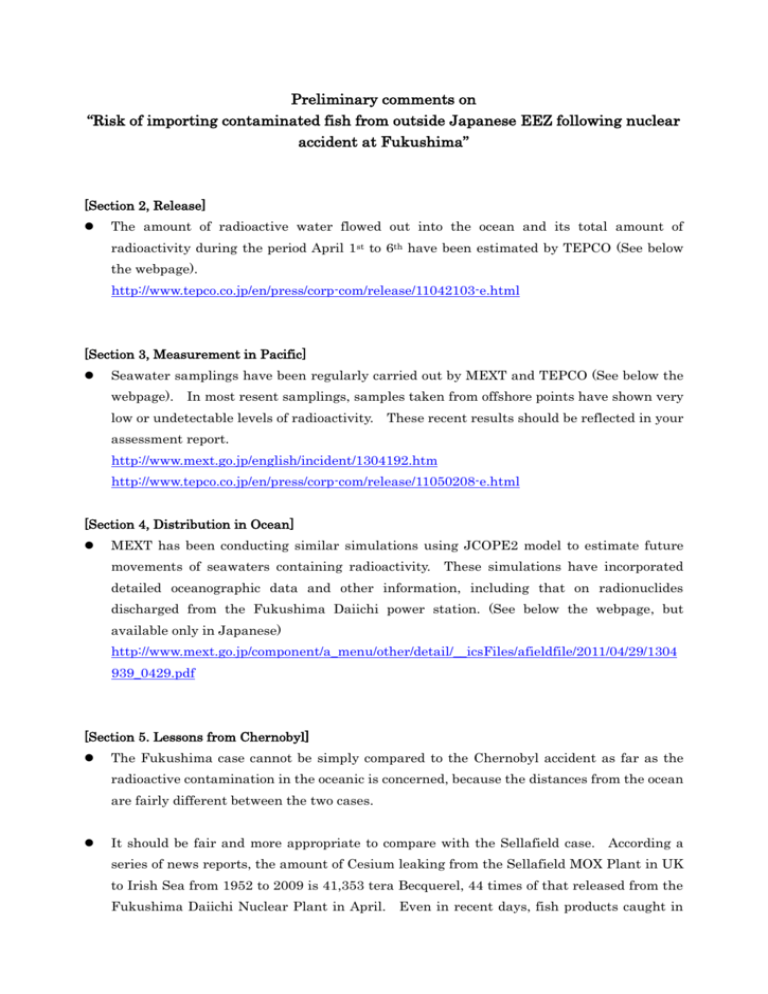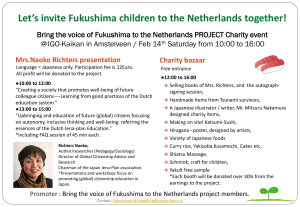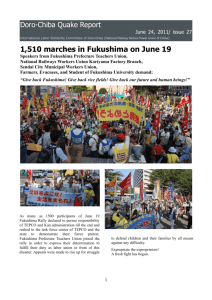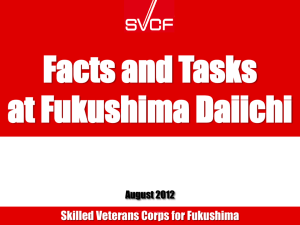Preliminary comments on “Risk of importing contaminated fish from
advertisement

Preliminary comments on “Risk of importing contaminated fish from outside Japanese EEZ following nuclear accident at Fukushima” [Section 2, Release] The amount of radioactive water flowed out into the ocean and its total amount of radioactivity during the period April 1st to 6th have been estimated by TEPCO (See below the webpage). http://www.tepco.co.jp/en/press/corp-com/release/11042103-e.html [Section 3, Measurement in Pacific] Seawater samplings have been regularly carried out by MEXT and TEPCO (See below the webpage). In most resent samplings, samples taken from offshore points have shown very low or undetectable levels of radioactivity. These recent results should be reflected in your assessment report. http://www.mext.go.jp/english/incident/1304192.htm http://www.tepco.co.jp/en/press/corp-com/release/11050208-e.html [Section 4, Distribution in Ocean] MEXT has been conducting similar simulations using JCOPE2 model to estimate future movements of seawaters containing radioactivity. These simulations have incorporated detailed oceanographic data and other information, including that on radionuclides discharged from the Fukushima Daiichi power station. (See below the webpage, but available only in Japanese) http://www.mext.go.jp/component/a_menu/other/detail/__icsFiles/afieldfile/2011/04/29/1304 939_0429.pdf [Section 5. Lessons from Chernobyl] The Fukushima case cannot be simply compared to the Chernobyl accident as far as the radioactive contamination in the oceanic is concerned, because the distances from the ocean are fairly different between the two cases. It should be fair and more appropriate to compare with the Sellafield case. According a series of news reports, the amount of Cesium leaking from the Sellafield MOX Plant in UK to Irish Sea from 1952 to 2009 is 41,353 tera Becquerel, 44 times of that released from the Fukushima Daiichi Nuclear Plant in April. Even in recent days, fish products caught in the area has radioactivity that is equivalent to a half of the recommended regulation value. http://www.bloomberg.com/news/2011-04-21/irradiated-lobsters-in-irish-sea-point-to-safe-ja pan-sushi-scientists-say.html http://search.japantimes.co.jp/cgi-bin/nn20110423f2.html [Section 6. Relationship between Concentration in Seawater and Concentration in Fish] The concentration factor of Cesium for fish estimated by IAEA is 100 (See Technical reports series No.422). Seemingly, you quoted the concentration factors of 50-400 from the Link [7] paper by INSTITUT DE RADIOPROTECTION, but we cannot find scientific paper verifying these concentration factors. http://www-pub.iaea.org/MTCD/publications/PDF/TRS422_web.pdf Any risk assessments should duly take into account recent offshore seawater sampling results by MEXO and TEPCO, as discussed in the above. [Section 7. Measurement in Fish] The measurement by using high pure germanium semiconductor detector is usually conducted one time, because the character of high pure germanium semiconductor detector does not need the repeated measurement. But the measurement value has value derived from the counting statistics, which is not shown in HP. This measurement method is reasonable in scientific field. See also the attached paper. (We have already replied with this answer to EU colleagues) Radioactive contamination exceeding the Provisional Regulation Value has been detected only in eight Japanese sandlance samples as of May 2nd (three samples were taken off northern part of Ibaraki Pref. and the rest five samples were taken off Iwaki City, Fukushima Pref.) In all the eight cases, the fish samples were taken from the coastal area close to the Fukushima Daiichi power plant. The description in your assessment report that the Japanese sandlance sample with high radioactivity was taken at “Iwa,” 500km away from Fukushima, must be a misinterpretation. All the Japanese sandlance sampled for the measurements were juvenile, not adult. Juvenile sandlance live on the surface of shallow coastal waters, which have a different living pattern from adult sandlance. We see inaccurate descriptions in Table 1. - Rainbow trout measured here was farmed fish in a freshwater pond. - Japanese amberjack is pelagic fish. - Japanese littleneck clam is benthos. - Juvenile sandlance measured here is pelagic fish, as mentioned above. [Section 8. Risk] As mentioned above, very low or undetectable levels of radioactivity have been detected in recent seawater samplings. Risk analysis should take into account the recent sampling results. The reason why albacore has not been subject to the monitoring programme is simply because fishing ground for that species has not yet formed offshore north eastern Japan. We see no grounds to specify albacore as a fish species with high risk. The monitoring programme will be carried out for a wide range of fish species, taking into account the situation of fishing grounds, flows of surface currents and other factors.











